| ESBR | Crime | Demography | Education | Health | SSBR |
|---|
| ESBR | Crime | Demography | Education | Health | SSBR |
|---|
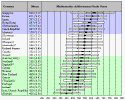 CHART: International comparisons |
International comparisons of mathematics and science proficiency 4th graders in the U.S. and 25 other countries, 8th graders in the U.S. and 40 other countries, and students in the final year of secondary school in the U.S. and 20 other countries U.S. 4th graders perform above the international average in both mathematics and science achievement. However, U.S. 8th graders score below the international average in mathematics achievement and above average in science achievement, and U.S. 12 graders score below the international average in mathematics and science achievement. |
||
|
Provided by
National Center for Education Statistics as of April 19, 1999. |
|||
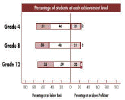 CHART: Civics Achievement |
Civics Achievement 4th, 8th, and 12th graders in 1998 At grades 4 and 8, almost half of the students scored in the Basic achievement level, while at grade 12, 39 percent of students were in the Basic achievement level range. |
||
|
Provided by
National Center for Education Statistics as of December 16, 1999. |
|||
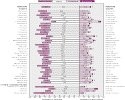 CHART: Writing Achievement |
Writing Achievement 8th graders in 1998 in the nation and participating states For 8th-grade public school students in the nation as a whole, 23 percent were at the Proficient achievement level, and 1 percent at the Advanced level. Among participating states and jurisdictions, the percentages of students at the Proficient level ranged from 8 percent to 40 percent, and the percentages at the Advanced level ranged from 0 percent to 6 percent. |
||
|
Provided by
National Center for Education Statistics as of September 30,1999. |
|||
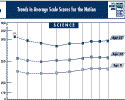 CHART: Trends in Academic Progress |
Trends in Academic Progress Science, Mathematics, Reading, and Writing Proficiency of 9-, 13-, and 17-year-olds The trends in science and mathematics show early declines or relative stability followed by improved performance. In reading, some modest improvement was evident in the trend assessments, but few indications of positive trends were evident in the writing results. |
||
|
Provided by
National Center for Education Statistics as of August 31, 1997. |
|||
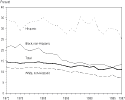 CHART: Status Dropout Rate |
Dropout Rate Trends in Status Dropouts, ages 16-24, by race-ethnicity In October of 1998, 11.8 percent of young adults in the United States were not enrolled in a high school program and had not completed high school. |
||
|
Provided by
National Center for Education Statistics as of December 16, 1999. |
|||
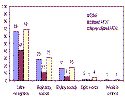 CHART: Kindergartners |
Cognitive Skills of Kindergartners Percentage of first-time kindergartners proficient in various reading and math skills: Fall 1998 In reading, 66 percent of kindergartners are proficient in recognizing their letters and 29 percent are proficient in understanding the beginning sounds. In math, nearly all first-time kindergartners are proficient in number and shape (recognizing numbers, shapes, and counting to 10) and 58 percent are proficient in understanding relative size. |
||
|
Provided by
National Center for Education Statistics as of March 27, 2000. |
|||
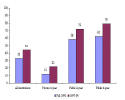 CHART: Distance Education |
Distance Education at Postsecondary Education Institutions Higher education institutions offering and enrollment in distance education courses In fall 1995, 33 percent of 2-year and 4-year higher education institutions offered distance education courses. In 1997-98, this had grown to 44 percent of 2-year and 4-year higher education institutions. |
||
|
Provided by
National Center for Education Statistics as of July 10, 2000. |
|||
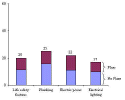 CHART: School Conditions |
Condition of Public School Facilities Percentage of schools with less than adequate building features and plans to repair: 1999 Among the 20 percent of public schools with less than adequate life safety features, 56 percent had no plans for major repair, renovation, or replacement in the next two years. |
||
|
Provided by
National Center for Education Statistics as of June 23, 2000. |
|||
 CHART: Doctoral Degrees Awarded in S&E and non-S&E fields |
Doctoral Degrees Awarded in Science and Engineering Fields In 1997, U.S. universities conferred 26,847 doctorate awards in science and engineering (S&E) fields, down from 27,230 in 1996. |
Previous 27,230 1996 |
Current 26,847 1997 |
|
Provided by
National Science Foundation/SRS as of March 23, 1999. |
|||
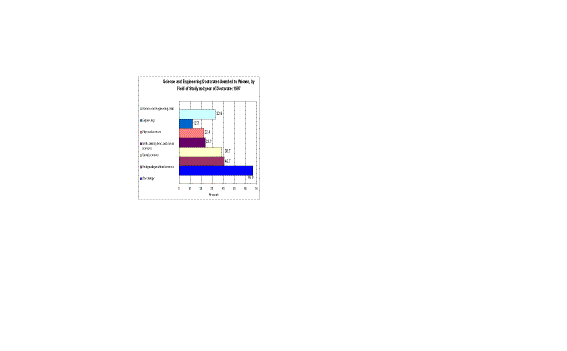 CHART: Percent Women Among S&E Doctorate Awards |
Percent of Doctorate Awards in Science & Engineering to Women The representation of women among science and engineering doctorate recipients continues to increase--women received 33 percent of all doctorates awarded in 1997 versus 27 percent in 1988. |
Previous 32.2% 1996 |
Current 32.8% 1997 |
|
Provided by
National Science Foundation/SRS as of September 15, 1999. |
|||
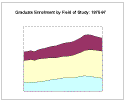 CHART: Graduate Enrollment, by Area of Study |
Graduate Enrollment in Science and Engineering After nearly two decades of steady increases, the number of graduate students in science and engineering has been in decline peaking at 435,886 in 1993. |
Previous 415,363 1996 |
Current 407,644 1997 |
|
Provided by
National Science Foundation/SRS as of October 27, 1999. |
|||
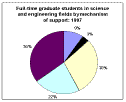 CHART: Full-time Graduate Students, by Mechanism of Support |
Percent of Full-time S&E Graduate Students Supported by Research Assistantships During the period 1984-97, the proportion of full-time science and engineering graduate students primarily supported under research assistantships increased from one-in-four to almost one-in-three. |
Previous 29.3% 1996 |
Current 29.7% 1997 |
|
Provided by
National Science Foundation/SRS as of October 27, 1999. |
|||
| ESBR | Crime | Demography | Education | Health | SSBR |
|---|
To comment on this service, send mail to feedback@www.whitehouse.gov.